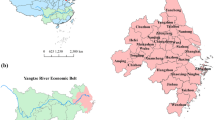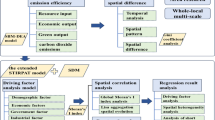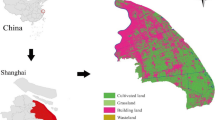Abstract
The development of urban low carbonization is an important foundation for achieving the goal of “dual carbon.” The differences in spatial differences based on scientific methods revealing the characteristics of urban carbon emissions and its efficiency are of great significance for shaping the green low-carbon land space pattern. This article uses urban standard models and scale adjustments to the urban index (SAMIs) identification in 2006–2017 308 Chinese urban carbon discharge standards and efficiency time and space evolution pattern and their characteristics. The results of the study show that there is a stable secondary relationship between carbon emissions and urban population scale, which means that the growth rate of urban carbon emissions is significantly lagging behind the growth of urban systems. The analysis of urban carbon emission efficiency based on SAMI values shows significant spatial heterogeneity: the carbon emission efficiency of cities in North China, East China, and Northeast China is lower than that of other regions. In terms of temporal changes, there was a phenomenon of SAMI high-value cities moving north and low-value cities moving south between 2006 and 2017, and △SAMIs showed a pattern of hot in the west and cold in the east. This study broadens the applicability of urban scaling law models in urban environmental research, providing a new perspective for evaluating urban carbon emission efficiency and China’s energy conservation and emission reduction work.






Similar content being viewed by others
Data availability
The datasets used and/or analyzed during the current study are available from the corresponding author on reasonable request.
References
Batty M (2008) The size, scale, and shape of cities. Science 319(5864):769–771. https://doi.org/10.1126/science.1151419
Bettencourt L (2013) The origins of scaling in cities. Science 340(6139):1438–1441. https://doi.org/10.1126/science.1235823\
Bettencourt L, Lobo J (2015) Urban scaling in Europe. J R Soc Interface 13(116):20160005. https://doi.org/10.1098/rsif.2016.0005
Bettencourt LM, Lobo J, Helbing D, Kühnert C, West GB (2007) Growth, innovation, scaling, and the pace of life in cities. Proc Natl Acad Sci 104(17):7301–7306. https://doi.org/10.1073/pnas.061017210
Bettencourt LM, Lobo J, Strumsky D, West GB (2010) Urban scaling and its deviations: revealing the structure of wealth, innovation and crime across cities. PloS one 5(11):e13541. https://doi.org/10.1371/journal.pone.0013541
Bettencourt L, Yang VC, Lobo J, Lobo J, Kempes CP, Rybski D, Hamilton MJ (2020) The interpretation of urban scaling analysis in time. J R Soc Interface 17(163):20190846. https://doi.org/10.1098/rsif.2019.0846
Cai B, Guo H, Ma Z, Wang Z, Dhakal S, Cao L (2019) Benchmarking carbon emissions efficiency in Chinese cities: a comparative study based on high-resolution gridded data. Appl Energy 242(PT.1-1284):994–1009. https://doi.org/10.1016/j.apenergy.2019.03.146
Chen L, Liu Y, Gao Y, Wang JJ (2021) Carbon emission trading policy and carbon emission efficiency: an empirical analysis of China’s prefecture-level cities. Front Energy Res 9:795601. https://doi.org/10.3389/fenrg.2021.793601
Dong F, Zhu J, Li YF, Chen YH, Gao YJ, Hu MY, Qin C, Sun JJ (2022) How green technology innovation affects carbon emission efficiency: evidence from developed countries proposing carbon neutrality targets. Environ Sci Pollut Res 29(24):35780–35799. https://doi.org/10.1007/s11356-022-18581-9
Gomez-Lievano A, Youn HJ, Bettencourt LM (2012) The statistics of urban scaling and their connection to Zipf’s law. PLoS ONE 7(7):e40393. https://doi.org/10.1371/journal.pone.0040393
Guo X, Wang X, Wu X, Chen XP, Li P (2022) Carbon emission efficiency and low-carbon optimization in Shanxi Province under “dual carbon” background. Energies 15(7):2369. https://doi.org/10.3390/en15072369
Han L, Zhou W, Li W (2018) Growing urbanization and the impact on fine particulate matter (PM2.5) dynamics. Sustainability 10(6):1696. https://doi.org/10.3390/su10061696
He YZ, Song W (2022) Analysis of the impact of carbon trading policies on carbon emission and carbon emission efficiency. Sustainability 14:10216. https://doi.org/10.3390/su141610216
Huang W, Wang Q, Li H, Fan H, Qian Y, Klemeš JJ (2022) Review of recent progress of emission trading policy in China. J Clean Prod 349:131480. https://doi.org/10.1016/j.jclepro.2022.131480
Huang H, Wei Z, Ge Q, Guo Q (2023) Analysis of spatial-temporal evolution and influencing factors of carbon emission efficiency in Chinese cities. Front Environ Sci 11:1119914. https://doi.org/10.3389/fenvs.2023.1119914
Jiao LM, Lei WQ, Xu G, Zhou Z (2020) Urban scaling and the spatio-temporal characteristics of scaling exponents in China. Acta Geogr Sin 75(12):2744–2758. https://doi.org/10.11821/dlxb202012014
Jin T, Kim J (2019) A comparative study of energy and carbon efficiency for emerging countries using panel stochastic frontier analysis. Sci Rep 9(1):6647. https://doi.org/10.1038/s41598-019-43178
Kaya Y, Yokobori K (1997) Environment, energy, and economy: strategies for sustainability(Vol. 4). Tokyo: United Nations University Press 56–59. https://doi.org/10.13140/RG.2.2.19997.61923
Li DZ, Chen HX, Hui E et al (2013) A methodology for estimating the life-cycle carbon efficiency of a residential building. Build Environ 59:448–455. https://doi.org/10.1016/j.buildenv.2012.09.012
Li YJ, Hou WH, Zhu WW, Li F, Liang L (2021) Provincial carbon emission performance analysis in China based on a Malmquist data envelopment analysis approach with fixed-sum undesirable outputs. Ann Oper Res 304(1–2):233–261. https://doi.org/10.1007/s10479-021-04062-8
Li R, Li L, Wang Q (2022) The impact of energy efficiency on carbon emissions: evidence from the transportation sector in Chinese 30 provinces. Sustain Cities Soc 82:103880. https://doi.org/10.1016/j.scs.2022.103880
Li SJ, Wang W, Diao H, Wang LM (2022) Measuring the efficiency of energy and carbon emissions: a review of definitions, models, and input-output variables. Energies 15(3):962. https://doi.org/10.3390/en15030962
Lin YC, Ma LW, Li Z, Ni WD (2022) The carbon reduction potential by improving technical efficiency from energy sources to final services in China: an extended Kaya identity analysis. Energy 263:125963. https://doi.org/10.1016/j.energy.2022.125963
Lv M, Bai M (2020) Evaluation of China’s carbon emission trading policy from corporate innovation. Finan Res Lett 39:101565. https://doi.org/10.1016/j.frl.2020.101565
Meng FY (2019) Carbon emissions efficiency and abatement cost under inter-region differentiated mitigation strategies: a modified DDF model. Phys A: Stat Mech Appl 532:121888. https://doi.org/10.1016/j.buildenv.2012.09.012
Oliveira EA, Andrade JS, Makse HA (2014) Large cities are less green. Rep 4(6174):4235. https://doi.org/10.1038/srep04235
Qu CY, Li LS, Cheng ZH (2017) Industry’s carbon emission efficiency of China’s manufacturing industry and its influence factors. Sci Technol Manag Res 37(08):60–68. https://doi.org/10.3969/j.issn.1000-7695.2017.08.009
Ribeiro HV, Oehlers M, Moreno-Monroy AI (2021) Association between population distribution and urban GDP scaling. PLoS ONE 16(1):e0245771. https://doi.org/10.1371/journal.pone.0245771
Shan Y, Guan D, Liu J, Mi Z, Liu Z, Liu J, Zhang Q (2017) Methodology and applications of city level CO2 emission accounts in China. J Clean Prod 161:1215–1225. https://doi.org/10.1016/j.jclepro.2017.06.075
Shan Y, Guan D, Hubacek K, Zheng B, Davis SJ, Jia L, Schellnhuber HJ (2018) City-level climate change mitigation in China. Sci Adv 4(6):eaaq0390. https://doi.org/10.1126/sciadv.aaq0390
Shan Y, Liu J, Liu Z, Shao S, Guan D (2019) An emissions-socioeconomic inventory of Chinese cities. Sci Data 6(1):1–10. https://doi.org/10.1038/sdata.2019.27
Shan Y, Guan Y, Hang Y, Zheng H, Li Y, Guan D, Hubacek K (2022) City-level emission peak and drivers in China. Sci Bull 67(18):1910–1920. https://doi.org/10.1016/j.scib.2022.08.024
Shao HH, Cheng JX, Wang YS, Li XM (2022) Can digital finance promote comprehensive carbon emission performance? Evidence from Chinese cities. Int J Environ Res Public Health 19:10255. https://doi.org/10.3390/ijerph191610255
Song A, Yang X, Zhang X, Wang F, Huang W (2019) Ecology environment research about carbon emission efficiency in china based on a novel super epsilon-based measures (SEBM) model. Appl Ecol Environ Res 17(1):1109–1128. https://doi.org/10.15666/aeer/1701_11091128
Sun W, Huang C (2020) How does urbanization affect carbon emission efficiency? Evidence from China. J Clean Prod 272(1–2):122828. https://doi.org/10.1016/j.jclepro.2020.122828
Sun W, Huang CC (2022) Predictions of carbon emission intensity based on factor analysis and an improved extreme learning machine from the perspective of carbon emission efficiency. J Clean Prod 338:130414. https://doi.org/10.1016/j.jclepro.2022.130414
Sun H, Edziah BK, Kporsu AK, Sarkodie SA, Taghizadeh-Hesary F (2021) Energy efficiency: the role of technological innovation and knowledge spillover. Technol Forecast Soc Chang 167:120659. https://doi.org/10.1016/j.techfore.2021.120659
Tang K, Xiong C, Wang Y, Zhou D (2021) Carbon emissions performance trend across Chinese cities: evidence from efficiency and convergence evaluation. Environ Sci Pollut Res 28(3):1533–1544. https://doi.org/10.1007/s11356-020-10518-4
Wang Q, Li L (2021) The effects of population aging, life expectancy, unemployment rate, population density, per capita GDP, urbanization on per capita carbon emissions. Sustain Prod Consum 28:760–774. https://doi.org/10.1016/j.spc.2021.06.029
Wang QW, Zhou P, Shen N et al (2013) Measuring carbon dioxide emission performance in Chinese provinces: a parametric approach. Renew Sustain Energy Rev 21:324–330. https://doi.org/10.1016/j.rser.2012.12.061
Wang KY, Wu M, Sun Y, Shi XP, Sun A, Zhang P (2019) Resource abundance, industrial structure, and regional carbon emissions efficiency in China. Resour Policy 60:203–214. https://doi.org/10.1016/j.resourpol.2019.01.001
Wang Q, Su M, Li R, Ponce P (2019) The effects of energy prices, urbanization and economic growth on energy consumption per capita in 186 countries. J Clean Prod 225:1017–1032. https://doi.org/10.1016/j.jclepro.2019.04.008
Wang Q, Wang X, Li R (2022) Does urbanization redefine the environmental Kuznets curve? An empirical analysis of 134 countries. Sustain Cities Soc 76:103. https://doi.org/10.1016/j.scs.2021.103382
Wang Q, Yang T, Li R (2023a) Does income inequality reshape the environmental Kuznets curve (EKC) hypothesis? A nonlinear panel data analysis. Environ Res 216:114575. https://doi.org/10.1016/j.envres.2022.114575
Wang Q, Zhang F, Li R (2023b) Revisiting the environmental Kuznets curve hypothesis in 208 counties: the roles of trade openness, human capital, renewable energy and natural resource rent. Environ Res 216:114637. https://doi.org/10.1016/j.envres.2022.114637
Wu H (2015) Provincial carbon emission reduction in China: spatial-temporal situation, evolution mechanism and policy recommendations: theory and methods based on spatial econometrics. Journal of Management World (11): 3–10. CNKI:SUN:GLSJ.0.2015–11–009
Xu ZB, Jiao LM, Jia QQ, Lei WQ, Lan T (2021) Assessment of multidimensional performance for Chinese cities based on urban scaling law. Geogr Res 40(06):1596–1609. https://doi.org/10.11821/dlyj020200537
Yang Y, Zhao LJ, Wang CC, Xue J (2021) Towards more effective air pollution governance strategies in China: a systematic review of the literature. J Clean Prod 297:126724. https://doi.org/10.1016/j.jclepro.2021.126724
Yao L, Xu WT, Xu Y, Sun S (2022) Examining the potential scaling law in urban PM2.5 pollution risks along with the nationwide air environmental effort in China. Int J Environ Res Public Health 19(8):4460. https://doi.org/10.3390/ijerph19084460
Zeng LG, Lu HY, Liu YP, Zhou Y, Hu HY (2019) Analysis of regional differences and influencing factors on China’s carbon emission efficiency in 2005–2015. Energies 12(16):3081. https://doi.org/10.3390/en12163081
Zhang C, Chen P (2021) Industrialization, urbanization, and carbon emission efficiency of Yangtze River economic belt—empirical analysis based on stochastic frontier model. Environ Sci Pollut Res 28:66914–66929. https://doi.org/10.1007/s11356-021-15309-z
Zhang A, Deng R (2022) Spatial-temporal evolution and influencing factors of net carbon sink efficiency in Chinese cities under the background of carbon neutrality. J Clean Prod 365:132547. https://doi.org/10.1016/j.jclepro.2022.132547
Zhou D, Zhang X, Wang X (2020) Research on coupling degree and coupling path between China’s carbon emission efficiency and industrial structure upgrading. Environ Sci Pollut Res 27(7):25149–25162. https://doi.org/10.1007/s11356-020-08993-w
Zhou Z, Cao L, Zhao KK, Li DL, Ding C (2021) Spatio-temporal effects of multi-dimensional urbanization on carbon emission efficiency: analysis based on panel data of 283 cities in China. Int J Environ Res Public Health 18(23):12712. https://doi.org/10.3390/ijerph182312712
Funding
This work was supported by the Major Program of National Social Science Foundation of China (No. 19ZD172), National Natural Science Foundation of China (42001334), Key Laboratory of Territorial Spatial Planning and Development-Protection of the Ministry of Natural Resources of PRC and CAUPD Beijing Planning & Design Consultants LTD (ID. TSPDP23/01), and Independent Innovation Fund for Young Teachers of Huazhong University of Science and Technology (ID. 2021WKYXQN031 and 2022WKFZZX025).
Author information
Authors and Affiliations
Contributions
This idea was given by Yingxue Rao and Qingsong He. Yi Zhong analyzed the data and wrote the complete paper. Qingsong He provided supervision and approved the final version.
Corresponding author
Ethics declarations
Ethical approval
Not applicable.
Consent to participate
I am free to contact any of the people involved in the research to seek further clarification and information.
Consent for publication
Not applicable.
Competing interests
The authors declare no competing interests.
Additional information
Responsible Editor: V.V.S.S. Sarma
Publisher's Note
Springer Nature remains neutral with regard to jurisdictional claims in published maps and institutional affiliations.
Rights and permissions
Springer Nature or its licensor (e.g. a society or other partner) holds exclusive rights to this article under a publishing agreement with the author(s) or other rightsholder(s); author self-archiving of the accepted manuscript version of this article is solely governed by the terms of such publishing agreement and applicable law.
About this article
Cite this article
Rao, Y., Zhong, Y. & He, Q. Evaluation of carbon emission efficiency based on urban scaling law: take 308 cities in China as an example. Environ Sci Pollut Res 30, 105166–105180 (2023). https://doi.org/10.1007/s11356-023-29634-y
Received:
Accepted:
Published:
Issue Date:
DOI: https://doi.org/10.1007/s11356-023-29634-y




